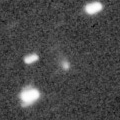
|
It brightened up to 15.1 mag in February (Feb. 1, Ken-ichi Kadota). It is expected to brighten up to 4.5 mag in April. However, it is not observable now. In the Northern Hemisphere, it will appear at 6 mag in mid May, and it stays observable in good condition after that while the comet will be fading. In the Southern Hemisphere, it is not observable until August.
Date(TT) R.A. (2000) Decl. Delta r Elong. m1 Best Time(A, h)
Mar. 26 0 46.32 -0 54.6 1.758 0.780 7 10.1 19:41 ( 99,-14)
Apr. 2 1 12.27 -1 6.8 1.590 0.624 9 9.0 19:47 (100,-16)
|
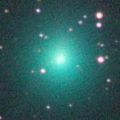
|
Brightened very rapidly. Now it is very bright as 9.3 mag (Mar. 24, Michael Jager). It stays 9-10 mag until spring. In the Northern Hemisphere, it will be unobservable soon. In the Southern Hemisphere, it is not observable until late May. But it will be observable in good condition after that.
Date(TT) R.A. (2000) Decl. Delta r Elong. m1 Best Time(A, h)
Mar. 26 0 33.30 30 37.2 1.769 1.016 28 10.3 19:41 (126, 3)
Apr. 2 0 54.14 26 52.0 1.849 0.999 22 10.3 19:47 (125, -2)
|
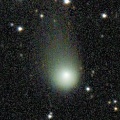
|
Now it is bright as 11.1 mag (Mar. 16, Ken-ichi Kadota). The brightness evolution is slower than originally expected. It is expected to be observable at 7 mag for a long time from 2022 to 2023. In the Northern Hemisphere, it stays observable in good condition until autumn. However, it is not observable at the high light from autumn to 2023 summer. In the Southern Hemisphere, it stays observable in good condition after this.
Date(TT) R.A. (2000) Decl. Delta r Elong. m1 Best Time(A, h)
Mar. 26 18 52.56 11 31.8 3.653 3.637 81 10.6 4:31 (301, 52)
Apr. 2 18 54.26 11 37.6 3.492 3.574 86 10.4 4:20 (305, 55)
|

|
Now it is 9.9 mag (Mar. 22, Chris Wyatt). In the Northern Hemisphere, it will be getting lower after this, and it will be unobservable in May. In the Southern Hemisphere, it stays observable until July.
Date(TT) R.A. (2000) Decl. Delta r Elong. m1 Best Time(A, h)
Mar. 26 6 39.70 17 28.3 3.403 3.620 94 10.5 19:41 ( 48, 66)
Apr. 2 6 43.11 16 30.2 3.519 3.633 88 10.6 19:47 ( 59, 60)
|
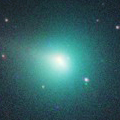
|
Now it is bright as 9.8 mag (Mar. 22, Chris Wyatt). It stays bright as 9-10 mag until March. In the Northern Hemisphere, it stays observable in excellent condition for a long time. In the Southern Hemisphere, it stays extremely low after this.
Date(TT) R.A. (2000) Decl. Delta r Elong. m1 Best Time(A, h)
Mar. 26 4 1.94 34 37.7 1.630 1.445 61 10.6 19:41 (107, 43)
Apr. 2 4 27.03 37 4.6 1.697 1.481 60 10.9 19:47 (111, 42)
|
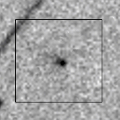
|
Now it is 11.8 mag (Mar. 4, Thomas Lehmann). In the Northern Hemisphere, it stays extremely low until spring. In the Southern Hemisphere, it stays observable at 11 mag until June.
Date(TT) R.A. (2000) Decl. Delta r Elong. m1 Best Time(A, h)
Mar. 26 21 17.92 -14 56.8 2.039 1.554 47 10.9 4:31 (295, 8)
Apr. 2 21 38.61 -13 34.3 2.012 1.560 49 10.9 4:20 (293, 8)
|
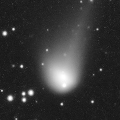
|
Now it is bright as 12.3 mag (Mar. 22, Chris Wyatt). It stays 11-12 mag until July. It stas observable in good condition for a long time. It locates high after this also in the Northern Hemisphere.
Date(TT) R.A. (2000) Decl. Delta r Elong. m1 Best Time(A, h)
Mar. 26 11 53.70 -22 44.2 3.345 4.288 158 11.5 23:38 ( 0, 32)
Apr. 2 11 51.00 -21 14.3 3.332 4.280 159 11.5 23:08 ( 0, 34)
|
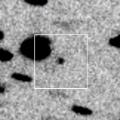
|
Now it is 13.4 mag (Mar. 4, Thomas Lehmann). It stays 12-13 mag for a while. But actually, it is fainter than this ephemeris recently. It is observable in excellent condition in the Southern Hemisphere. It locates low until May in the Northern Hemisphere.
Date(TT) R.A. (2000) Decl. Delta r Elong. m1 Best Time(A, h)
Mar. 26 19 59.63 -22 47.8 1.635 1.558 67 12.2 4:31 (314, 16)
Apr. 2 20 20.30 -22 34.6 1.601 1.569 69 12.2 4:20 (313, 15)
|
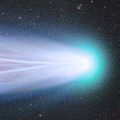
|
It brightened up to 3 mag from mid December to late December. Now it is fading. It has already faded down to 10.8 mag (Mar. 5, Thomas Lehmann). In the Northern Hemisphere, it will become observable again at 13 mag in late April.
Date(TT) R.A. (2000) Decl. Delta r Elong. m1 Best Time(A, h)
Mar. 26 21 8.71 -35 11.2 1.973 1.671 57 12.2 4:31 (311, -4)
Apr. 2 21 2.05 -35 32.7 1.935 1.775 65 12.4 4:20 (315, 0)
|

|
It has not been observed yet in this apparition. It will brighten very rapidly up to 9 mag in May. The condition is very bad in this apparition. It is observable only in the extremely low sky from mid May to mid July in the Northern Hemisphere, or from early June to early August in the Southern Hemisphere.
Date(TT) R.A. (2000) Decl. Delta r Elong. m1 Best Time(A, h)
Mar. 26 23 43.33 -3 53.8 1.783 0.823 10 13.5 4:31 (265,-14)
Apr. 2 0 18.30 -0 1.9 1.709 0.732 7 12.2 4:20 (259,-16)
|
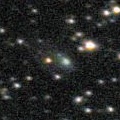
|
Now it is 13.6 mag (Mar. 20, ATLAS Chile). It is expected to brighten up to 11 mag from spring to summer. In the Southen Hemisphere, it stays observable in good condition for a long time after this. In the Northern Hemisphere, it is hardly observable after this.
Date(TT) R.A. (2000) Decl. Delta r Elong. m1 Best Time(A, h)
Mar. 26 20 42.01 -24 3.4 2.370 2.036 58 13.0 4:31 (307, 8)
Apr. 2 20 50.25 -26 36.2 2.209 1.995 64 12.7 4:20 (310, 8)
|
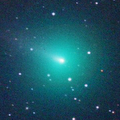
|
It brightened very rapidly up to 9.2 mag in winter (Jan. 31, Chris Wyatt). Now it is fading. But it is still bright as 11.2 mag (Mar. 22, Chris Wyatt). It will be fainter than 18 mag in May.
Date(TT) R.A. (2000) Decl. Delta r Elong. m1 Best Time(A, h)
Mar. 26 6 35.46 15 33.2 0.970 1.434 93 13.0 19:41 ( 47, 64)
Apr. 2 7 1.47 15 39.2 1.055 1.490 92 13.7 19:47 ( 50, 63)
|

|
Now it is 14.1 mag (Mar. 22, Chris Wyatt). It was expected to brighten up to 13 mag in spring. But actually, it is fainter than this ephemeris recently. In the Southern Hemisphere, it stays observable in good condition for a long time. In the Northern Hemisphere, it is not observable until autumn.
Date(TT) R.A. (2000) Decl. Delta r Elong. m1 Best Time(A, h)
Mar. 26 7 27.57 -64 51.2 2.925 3.236 99 13.4 19:41 ( 3,-10)
Apr. 2 7 7.58 -62 11.9 2.942 3.219 96 13.4 19:47 ( 10, -9)
|
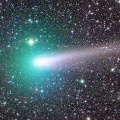
|
It brightened up to 8.5 mag from autumn to winter (Dec. 2, Toshihiko Ikemura, Hirohisa Sato). Now it is fading. It has already faded down to 13.3 mag (Mar. 22, Chris Wyatt). It stays observable in good condition for a long time.
Date(TT) R.A. (2000) Decl. Delta r Elong. m1 Best Time(A, h)
Mar. 26 8 37.70 24 3.3 1.348 2.043 120 13.5 20:23 ( 0, 79)
Apr. 2 8 44.04 23 15.2 1.468 2.099 115 13.9 20:02 ( 0, 78)
|
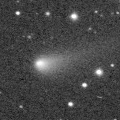
|
Now it is 13.2 mag (Mar. 22, Chris Wyatt). It is observable at 13 mag in good condition until early summer.
Date(TT) R.A. (2000) Decl. Delta r Elong. m1 Best Time(A, h)
Mar. 26 9 24.95 19 15.2 1.542 2.334 132 13.6 21:10 ( 0, 74)
Apr. 2 9 24.84 18 57.5 1.589 2.318 125 13.6 20:42 ( 0, 74)
|

|
Now it is bright as 12.7 mag (Feb. 27, Toshihiko Ikemura, Hirohisa Sato). It is observable until April in the Southern Hemisphere, or until May in the Northern Hemisphere.
Date(TT) R.A. (2000) Decl. Delta r Elong. m1 Best Time(A, h)
Mar. 26 4 32.16 29 4.0 6.306 5.970 65 13.8 19:41 ( 97, 47)
Apr. 2 4 36.45 29 2.9 6.408 5.972 60 13.9 19:47 (100, 41)
|
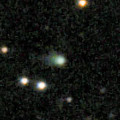
|
Now it is 14.1 mag (Mar. 2, Toshihiko Ikemura, Hirohisa Sato). It is expected to brighten up to 11 mag in 2023. In the Northern Hemisphere, it stays observable in good condition for a long time. In the Southern Hemisphere, it locates extremely low in 2022, but it will be observable in good condition in 2023.
Date(TT) R.A. (2000) Decl. Delta r Elong. m1 Best Time(A, h)
Mar. 26 16 20.44 39 56.6 4.417 4.862 110 14.0 4:08 (180, 85)
Apr. 2 16 12.34 40 57.3 4.327 4.823 114 13.9 3:32 (180, 84)
|
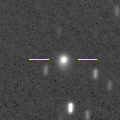
|
Now it is 13.4 mag (Feb. 28, Toshihiko Ikemura, Hirohisa Sato). It is expected to brighten up to 10 mag in 2023. In the Northern Hemisphere, it stays observable in good condition until 2023 autumn. In the Southern Hemipshere, it stays unobservable until 2023 summer.
Date(TT) R.A. (2000) Decl. Delta r Elong. m1 Best Time(A, h)
Mar. 26 11 41.50 60 20.8 4.277 4.816 117 14.0 23:25 (180, 65)
Apr. 2 11 25.93 61 1.0 4.286 4.760 112 13.9 22:42 (180, 64)
|

|
Now it is 15.8 mag (Mar. 15, Slooh.com Chile Observatory). It will brighten up to 13 mag in summer.
Date(TT) R.A. (2000) Decl. Delta r Elong. m1 Best Time(A, h)
Mar. 26 18 40.13 -26 24.6 2.987 3.083 86 14.2 4:31 (332, 23)
Apr. 2 18 47.04 -26 37.0 2.886 3.077 91 14.1 4:20 (334, 23)
|

|
Now it is 15.7 mag (Feb. 2, Thomas Lehmann). It will brighten up to 12.5 mag in summer. In the Southern Hemisphere, it stays observable in excellent condition for a long time, although it became low temporarily in February. In the Northern Hemisphere, it is not observable until August.
Date(TT) R.A. (2000) Decl. Delta r Elong. m1 Best Time(A, h)
Mar. 26 22 45.17 -54 7.6 3.819 3.420 59 14.3 4:31 (318,-28)
Apr. 2 22 47.10 -54 1.7 3.711 3.387 63 14.1 4:20 (319,-26)
|

|
It brightened up to 12.3 mag from spring to summer (June 15, Marco Goiato). Now it is fading. It has already faded down to 14.7 mag (Feb. 27, Toshihiko Ikemura, Hirohisa Sato).
Date(TT) R.A. (2000) Decl. Delta r Elong. m1 Best Time(A, h)
Mar. 26 13 31.48 24 45.4 3.699 4.574 147 14.3 1:20 ( 0, 80)
Apr. 2 13 21.29 26 22.5 3.740 4.616 147 14.3 0:42 ( 0, 81)
|
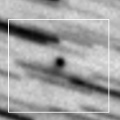
|
Now it is 14.3 mag (Mar. 8, Thomas Lehmann). It is expected to brighten up to 11 mag in summer. In the Northern Hemisphere, it stays observable in good condition until June when it brightens up to 11 mag. But it is not observable after the high light. In the Souther Hemisphere, it is not observable until October.
Date(TT) R.A. (2000) Decl. Delta r Elong. m1 Best Time(A, h)
Mar. 26 1 3.25 55 18.6 2.627 2.196 54 14.5 19:41 (143, 22)
Apr. 2 1 25.67 56 18.9 2.573 2.115 52 14.3 19:47 (145, 21)
|
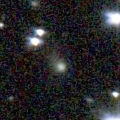
|
Now it is 15.2 mag (Mar. 2, Toshihiko Ikemura, Hirohisa Sato). It is expected to brighten up to 11 mag in 2023. In the Northern Hemisphere, it stays observable in good condition until November. But it becomes unobservable after that. In the Southern Hemisphere, it stays observable in good condition after this.
Date(TT) R.A. (2000) Decl. Delta r Elong. m1 Best Time(A, h)
Mar. 26 19 1.32 17 58.2 4.988 4.900 79 14.8 4:31 (290, 55)
Apr. 2 19 2.39 18 11.0 4.852 4.853 84 14.7 4:20 (294, 58)
|

|
Now it is 15.9 mag (Mar. 5, Thomas Lehmann). It stays at 15-16 mag for a long time. In the Southern Hemisphere, it stays observable in excellent condition for a long time. In the Northern Hemiphere, it locates extremely low in spring.
Date(TT) R.A. (2000) Decl. Delta r Elong. m1 Best Time(A, h)
Mar. 26 17 14.68 -41 22.5 4.791 5.112 103 15.0 4:31 (354, 13)
Apr. 2 17 10.37 -42 37.6 4.691 5.124 110 15.0 4:20 (358, 12)
|
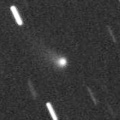
|
Now it is 14.3 mag (Mar. 2, Toshihiko Ikemura, Hirohisa Sato). It became brighter after the perihelion passage. It stays observable at 14-15 mag for a long time.
Date(TT) R.A. (2000) Decl. Delta r Elong. m1 Best Time(A, h)
Mar. 26 11 20.66 8 33.6 2.717 3.679 162 15.0 23:04 ( 0, 63)
Apr. 2 11 9.23 7 53.8 2.798 3.718 153 15.1 22:26 ( 0, 63)
|
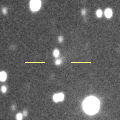
|
Now it is 15.3 mag (Mar. 9, Ken-ichi Kadota). It continues brightening even after the perihelion passage. It is observable at 15 mag in good condition for a while.
Date(TT) R.A. (2000) Decl. Delta r Elong. m1 Best Time(A, h)
Mar. 26 10 18.21 -7 29.1 1.538 2.450 149 15.3 22:03 ( 0, 48)
Apr. 2 10 20.09 -4 36.2 1.591 2.472 144 15.4 21:38 ( 0, 50)
|
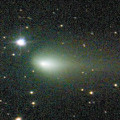
|
It brightened up to 10.6 mag in autumn (Oct. 10, Osamu Miyazaki). Now it is fading. It has already faded down to 13.8 mag (Mar. 15, Ken-ichi Kadota). It stays observable in good condition for a long time.
Date(TT) R.A. (2000) Decl. Delta r Elong. m1 Best Time(A, h)
Mar. 26 6 54.10 14 17.7 2.127 2.474 98 15.4 19:41 ( 37, 65)
Apr. 2 7 2.23 14 33.5 2.254 2.517 93 15.7 19:47 ( 49, 62)
|
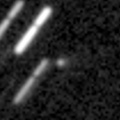
|
Now it is 17.0 mag (Mar. 21, ATLAS-MLO, Mauna Loa). It is expected to brighten up to 11 mag from summer to autumn. It stays observable in good condition in the Southern Hemisphere. In the Northern Hemisphere, it becomes extremely low from August to September.
Date(TT) R.A. (2000) Decl. Delta r Elong. m1 Best Time(A, h)
Mar. 26 9 57.07 32 1.2 1.311 2.115 132 15.7 21:41 ( 0, 87)
Apr. 2 9 49.55 31 59.1 1.314 2.054 124 15.4 21:07 ( 0, 87)
|
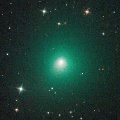
|
It brightened up to 9.5 mag in early summer in 2021 (June 27, Marco Goiato). Now it is fading. It has faded down to 12.7 mag in autumn (Nov. 22, Thomas Lehmann). In the Southern Hemisphere, it is appearing in the morning sky. In the Northern Hemisphere, it is not observable until June when the comet will fade down to 17 mag.
Date(TT) R.A. (2000) Decl. Delta r Elong. m1 Best Time(A, h)
Mar. 26 22 7.67 -30 55.0 4.182 3.551 45 15.9 4:31 (300,-11)
Apr. 2 22 17.12 -30 47.4 4.172 3.610 49 16.0 4:20 (301, -9)
|
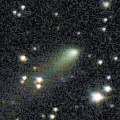
|
Now it is 15.9 mag (Mar. 2, ATLAS-MLO, Mauna Loa). It will be fading after this. In the Northern Hemisphere, it stays observable in good condition for a long time. It locates low in the Southern Hemisphere.
Date(TT) R.A. (2000) Decl. Delta r Elong. m1 Best Time(A, h)
Mar. 26 14 1.92 44 19.7 2.286 3.007 128 16.0 1:51 (180, 81)
Apr. 2 13 34.96 45 16.7 2.327 3.054 128 16.1 0:57 (180, 80)
|
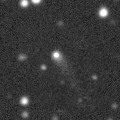
|
Now it is 15.9 mag (Mar. 6, Toshihiko Ikemura, Hirohisa Sato). It stays observable at 16 mag from 2021 to 2022.
Date(TT) R.A. (2000) Decl. Delta r Elong. m1 Best Time(A, h)
Mar. 26 16 20.34 28 45.2 4.406 4.904 114 16.1 4:08 ( 0, 84)
Apr. 2 16 19.23 30 39.0 4.376 4.920 117 16.1 3:39 ( 0, 86)
|
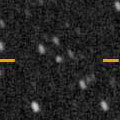
|
Now it is 16.1 mag (Mar. 21, D. Buczynski). It will approach to Earth down to 0.29 a.u. in 2023 February, and it is expected to brighten up to 5 mag. In the Northern Hemisphere, it stays observable in excellent condition. In the Southern Hemisphere, it becomes unobservable from late September to early February.
Date(TT) R.A. (2000) Decl. Delta r Elong. m1 Best Time(A, h)
Mar. 26 20 9.39 5 29.6 4.401 4.034 62 16.3 4:31 (289, 34)
Apr. 2 20 11.58 6 47.4 4.231 3.961 67 16.1 4:20 (291, 38)
|
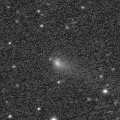
|
Now it is 16.0 mag (Mar. 9, Toshihiko Ikemura, Hirohisa Sato). It is bright as 14.8 mag visually (Mar. 1, Sandor Szabo). It will be fading after this, and it will be fainter than 18 mag in June.
Date(TT) R.A. (2000) Decl. Delta r Elong. m1 Best Time(A, h)
Mar. 26 11 29.54 13 32.3 1.344 2.308 160 16.1 23:14 ( 0, 68)
Apr. 2 11 26.08 13 52.3 1.398 2.334 153 16.3 22:43 ( 0, 69)
|

|
Now it is 19.2 mag (Feb. 28, Hidetaka Sato). It was expected to be observable at 16 mag in good condition in spring. But actually, it is fainter than predicted by 3 mag.
Date(TT) R.A. (2000) Decl. Delta r Elong. m1 Best Time(A, h)
Mar. 26 19 1.33 -29 6.1 1.184 1.432 81 16.2 4:31 (329, 18)
Apr. 2 19 23.39 -26 55.3 1.148 1.432 83 16.1 4:20 (326, 19)
|
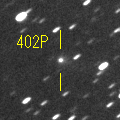
|
First return of a new periodic comet observed at 16 mag from 2003 to 2004. Now it is 16.3 mag (Feb. 26, Toshihiko Ikemura, Hirohisa Sato). It will be unobservable in June. But it will become observable again at 17 mag from autum to winter.
Date(TT) R.A. (2000) Decl. Delta r Elong. m1 Best Time(A, h)
Mar. 26 6 11.33 14 4.0 3.892 3.981 87 16.5 19:41 ( 55, 59)
Apr. 2 6 15.73 14 47.7 4.001 3.987 82 16.5 19:47 ( 65, 54)
|
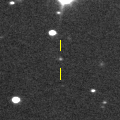
|
Now it is 17.0 mag (Mar. 3, Toshihiko Ikemura, Hirohisa Sato). It will brighten up to 11.5 mag in 2022 winter. It stays observable while the comet will be brightening slowly.
Date(TT) R.A. (2000) Decl. Delta r Elong. m1 Best Time(A, h)
Mar. 26 3 45.14 17 20.5 3.287 2.803 53 16.6 19:41 ( 89, 32)
Apr. 2 3 54.22 17 54.7 3.324 2.763 48 16.5 19:47 ( 94, 27)
|
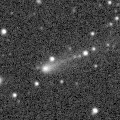
|
It brightened rapidly. Now it is 15.8 mag (Mar. 3, Toshihiko Ikemura, Hirohisa Sato). It stays observable in good condition for a while. But it will fade out rapidly after this, and it will be fainter than 18 mag in May.
Date(TT) R.A. (2000) Decl. Delta r Elong. m1 Best Time(A, h)
Mar. 26 7 55.83 12 48.8 2.080 2.638 113 16.5 19:41 ( 0, 68)
Apr. 2 7 59.69 12 33.6 2.178 2.653 107 16.7 19:47 ( 18, 67)
|
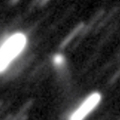
|
Now it is 16.3 mag (Mar. 3, Toshihiko Ikemura, Hirohisa Sato). It was observed at 15 mag in 2021. Now it is fading. It stays observable at 16-17 mag for a while in 2022.
Date(TT) R.A. (2000) Decl. Delta r Elong. m1 Best Time(A, h)
Mar. 26 18 44.86 11 22.7 5.150 5.127 83 16.6 4:31 (303, 54)
Apr. 2 18 46.37 12 54.1 5.076 5.145 88 16.6 4:20 (306, 57)
|
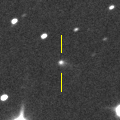
|
Now it is 16.9 mag (Mar. 8, Michael Jager). It will brighten up to 14 mag in early 2023. It becomes unobservable temporarily in May. But it will appear in the morning sky again in August.
Date(TT) R.A. (2000) Decl. Delta r Elong. m1 Best Time(A, h)
Mar. 26 4 37.89 10 17.7 4.790 4.460 64 16.7 19:41 ( 74, 39)
Apr. 2 4 43.12 10 56.8 4.843 4.420 59 16.7 19:47 ( 79, 34)
|
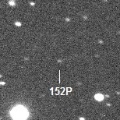
|
It will brighten up to 16 mag from spring to summer. It locates somewhat low in the Northern Hemisphere.
Date(TT) R.A. (2000) Decl. Delta r Elong. m1 Best Time(A, h)
Mar. 26 19 20.52 -21 55.1 3.199 3.119 76 16.8 4:31 (321, 22)
Apr. 2 19 28.11 -21 54.3 3.110 3.124 81 16.8 4:20 (323, 23)
|

|
Brightened rapidly. Now it is 16.5 mag (Mar. 3, Toshihiko Ikemura, Hirohisa Sato). It will be too low to observe soon.
Date(TT) R.A. (2000) Decl. Delta r Elong. m1 Best Time(A, h)
Mar. 26 3 11.22 14 10.8 4.526 3.877 44 16.8 19:41 ( 91, 24)
Apr. 2 3 19.37 14 34.2 4.604 3.885 39 16.9 19:47 ( 95, 19)
|
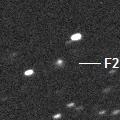
|
Now it is 17.0 mag (Mar. 12, ATLAS-MLO, Mauna Loa). It stays observable at 17-18 mag for a long time until 2024.
Date(TT) R.A. (2000) Decl. Delta r Elong. m1 Best Time(A, h)
Mar. 26 14 16.22 -0 41.3 7.959 8.841 150 16.9 2:04 ( 0, 54)
Apr. 2 14 11.94 -0 7.5 7.906 8.838 157 16.9 1:33 ( 0, 55)
|
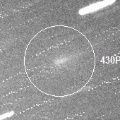
|
First return of a new periodic comet which brightened up to 17 mag in 2011. Now it is extremely faint as 20.4 mag (Feb. 4, J.-G. Bosch, F. Kugel, A. Klotz, J. Nicolas). It brightened up to 16.8 mag in October (Oct. 10, Ken-ichi Kadota), however, it has been fading after that.
Date(TT) R.A. (2000) Decl. Delta r Elong. m1 Best Time(A, h)
Mar. 26 15 33.57 -15 58.4 1.084 1.886 129 16.9 3:22 ( 0, 39)
Apr. 2 15 32.00 -16 9.1 1.064 1.922 137 17.0 2:53 ( 0, 39)
|

|
Brightened rapidly up to 16.4 mag in autumn (Nov. 14, F. Kugel, M. Audejean, J. Nicolas, J.-G. Bosch). It stays 17 mag for a long time from 2021 to 2022. In the Southern Hemisphere, it stays observable in good condition for a long time. In the Northern Hemisphere, it locates extremely low, and it is observable only until April. It is fainter than this ephemeris recently, 17.9 mag (Mar. 3, J. Drummond).
Date(TT) R.A. (2000) Decl. Delta r Elong. m1 Best Time(A, h)
Mar. 26 6 46.98 -44 34.2 5.217 5.421 96 16.9 19:41 ( 12, 9)
Apr. 2 6 43.86 -43 56.9 5.281 5.431 93 17.0 19:47 ( 19, 7)
|

|
Now it is 16.9 mag (Mar. 6, Toshihiko Ikemura, Hirohisa Sato). Fading slowly. In the Northern Hemisphere, it stays observable in good condition for a long time. In the Southern Hemisphere, it is not observable after this.
Date(TT) R.A. (2000) Decl. Delta r Elong. m1 Best Time(A, h)
Mar. 26 19 24.20 56 47.1 9.224 9.093 79 17.0 4:31 (218, 55)
Apr. 2 19 24.77 57 50.9 9.213 9.103 80 17.0 4:20 (215, 57)
|
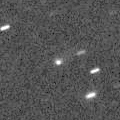
|
Now it is 16.9 mag (Mar. 12, ATLAS-MLO, Mauna Loa). It will be observable at 17 mag in good condition in spring.
Date(TT) R.A. (2000) Decl. Delta r Elong. m1 Best Time(A, h)
Mar. 26 13 35.13 -9 12.7 3.759 4.707 159 17.0 1:23 ( 0, 46)
Apr. 2 13 31.93 -8 58.3 3.726 4.706 167 17.0 0:53 ( 0, 46)
|
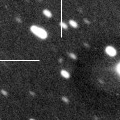
|
Now it is 16.9 mag (Mar. 8, Toshihiko Ikemura, Hirohisa Sato). It will brighten up to 13-14 mag from 2024 to 2025.
Date(TT) R.A. (2000) Decl. Delta r Elong. m1 Best Time(A, h)
Mar. 26 7 9.54 -28 30.4 7.961 8.229 102 17.2 19:41 ( 11, 26)
Apr. 2 7 10.19 -27 58.0 7.993 8.192 98 17.1 19:47 ( 19, 24)
|
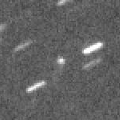
|
Now it is 17.1 mag (Mar. 4, A. Diepvens). It started fading before the perihelion passage. It was predicted to stay at 16 mag for a long time, but actually, it will be fainter than 18 mag in autumn. In the Northern Hemisphere, it stays observable in good condition for a long time. In the Southern Hemisphere, it is not observable until 2023.
Date(TT) R.A. (2000) Decl. Delta r Elong. m1 Best Time(A, h)
Mar. 26 23 57.34 74 59.5 3.935 3.767 73 17.3 4:31 (196, 29)
Apr. 2 0 3.35 74 58.1 3.977 3.763 70 17.3 4:20 (197, 30)
|
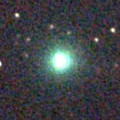
|
It brightened very rapidly, and brightened up to 8.9 mag (Sept. 11, Chris Wyatt). Now it is fading. It has already faded down to 19 mag (Mar. 19, WISE). In the Southern Hemisphere, it stays observable after this while the comet will be fading. It is not observable after this in the Northern Hemisphere.
Date(TT) R.A. (2000) Decl. Delta r Elong. m1 Best Time(A, h)
Mar. 26 18 0.16 -56 36.3 2.604 2.855 94 17.4 4:31 (349, -3)
Apr. 2 17 58.23 -56 54.8 2.573 2.920 100 17.6 4:20 (352, -3)
|
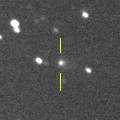
|
Now it is 17.7 mag (Mar. 8, Michael Jager). It continued brightening for a while even after the perihelion passage. It stays observable at 17 mag in good condition for a while.
Date(TT) R.A. (2000) Decl. Delta r Elong. m1 Best Time(A, h)
Mar. 26 4 45.23 -0 43.6 4.431 4.140 66 17.6 19:41 ( 62, 33)
Apr. 2 4 50.62 0 11.9 4.538 4.159 61 17.7 19:47 ( 68, 28)
|
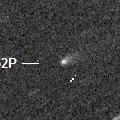
|
It brightened up to 16.4 mag from autumn to winter (Oct. 6, ATLAS-MLO, Mauna Loa). Now it is fading. It has already faded down to 18.0 mag (Feb. 28, Toshihiko Ikemura, Hirohisa Sato).
Date(TT) R.A. (2000) Decl. Delta r Elong. m1 Best Time(A, h)
Mar. 26 12 25.73 -12 57.6 1.368 2.354 168 17.6 0:14 ( 0, 42)
Apr. 2 12 19.10 -12 44.1 1.402 2.392 169 17.8 23:36 ( 0, 42)
|
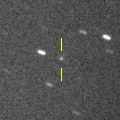
|
Now it is 17.4 mag (Mar. 3, Toshihiko Ikemura, Hirohisa Sato). It will brighten up to 16 mag in 2023. In the Southern Hemisphere, it stays observable in good condition for a long time. In the Northern Hemisphere, it is observable only until May.
Date(TT) R.A. (2000) Decl. Delta r Elong. m1 Best Time(A, h)
Mar. 26 9 51.27 -16 23.9 3.585 4.406 141 17.7 21:36 ( 0, 38)
Apr. 2 9 46.71 -16 25.8 3.600 4.364 135 17.7 21:04 ( 0, 38)
|
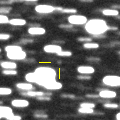
|
Now it is 17.2 mag (Mar. 8, Toshihiko Ikemura, Hirohisa Sato). It will brighten up to 15-16 mag in 2023. Cometary activity was detected by Cristovao Jacques on Dec. 12, and by Luca Buzzi and Andrea Aletti on Feb. 23.
Date(TT) R.A. (2000) Decl. Delta r Elong. m1 Best Time(A, h)
Mar. 26 6 25.10 -17 18.2 4.927 5.064 92 17.7 19:41 ( 26, 33)
Apr. 2 6 22.01 -16 20.3 4.986 5.018 86 17.7 19:47 ( 36, 30)
|
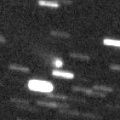
|
Now it is 17.1 mag (Feb. 28, Hidetaka Sato). It was observed at 16 mag from 2020 to 2021. Now it is fading. It will be fainter than 18 mag in May.
Date(TT) R.A. (2000) Decl. Delta r Elong. m1 Best Time(A, h)
Mar. 26 15 10.56 -41 28.3 5.458 6.082 124 17.7 2:59 ( 0, 13)
Apr. 2 15 2.65 -41 54.4 5.406 6.116 131 17.7 2:24 ( 0, 13)
|

|
Now it is 17.8 mag (Mar. 2, Toshihiko Ikemura, Hirohisa Sato). In the Northern Hemisphere, it stays observable for a long time while it is getting fainter slowly. It locates extremely low in the Southern Hemisphere.
Date(TT) R.A. (2000) Decl. Delta r Elong. m1 Best Time(A, h)
Mar. 26 14 33.64 46 56.0 7.442 8.026 122 17.7 2:22 (180, 78)
Apr. 2 14 28.72 47 11.0 7.483 8.073 123 17.7 1:49 (180, 78)
|
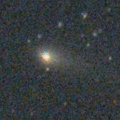
|
It brightened up to 13.1 mag in autumn (Oct. 28, Toshihiko Ikemura, Hirohisa Sato). Now it is fading. It has already faded down to 17.0 mag (Mar. 13, Catalina Sky Survey). It stays observable in good condition for a long time.
Date(TT) R.A. (2000) Decl. Delta r Elong. m1 Best Time(A, h)
Mar. 26 4 31.50 17 3.9 2.355 2.115 63 17.7 19:41 ( 82, 42)
Apr. 2 4 46.59 17 43.7 2.459 2.153 60 18.0 19:47 ( 86, 38)
|
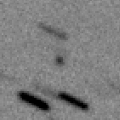
|
Now it is 17.8 mag (Feb. 27, Toshihiko Ikemura, Hirohisa Sato). It is observable in good condition in the Northern Hemisphere, but it locates low in the Southern Hemisphere. It will be fainter than 18 mag soon.
Date(TT) R.A. (2000) Decl. Delta r Elong. m1 Best Time(A, h)
Mar. 26 6 2.09 32 47.1 2.323 2.455 85 17.7 19:41 ( 93, 67)
Apr. 2 6 12.78 32 55.6 2.404 2.454 80 17.8 19:47 ( 96, 62)
|

|
It has not been observed yet in this apparition. appearing in the morning sky. It will brighten up to 15 mag in autumn, and it will be observable in good condition.
Date(TT) R.A. (2000) Decl. Delta r Elong. m1 Best Time(A, h)
Mar. 26 22 0.18 -9 55.0 3.365 2.630 36 17.9 4:31 (284, 3)
Apr. 2 22 12.09 -8 55.6 3.284 2.602 40 17.8 4:20 (284, 5)
|
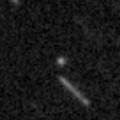
|
First return of a new periodic comet which brightened up to 16.5 mag in 1997. Now it is 17.5 mag (Mar. 9, Hirohisa Sato). It was fainter than originally predicted at the recovery, but it brightened very rapidly. It will be fading after this, and it will be fainter than 18 mag in April.
Date(TT) R.A. (2000) Decl. Delta r Elong. m1 Best Time(A, h)
Mar. 26 8 32.09 18 20.1 1.359 2.057 120 17.9 20:18 ( 0, 73)
Apr. 2 8 37.74 17 1.1 1.418 2.056 115 17.9 19:56 ( 0, 72)
|
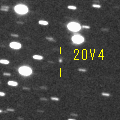
|
Now it is 18.1 mag (Mar. 10, ATLAS-HKO, Haleakala). It will be fainter than 18 mag soon.
Date(TT) R.A. (2000) Decl. Delta r Elong. m1 Best Time(A, h)
Mar. 26 7 38.45 6 8.8 4.883 5.303 109 17.9 19:41 ( 9, 61)
Apr. 2 7 39.85 6 26.4 4.991 5.311 103 18.0 19:47 ( 25, 59)
|
|
![]()
 C/2021 E3 ( ZTF )
C/2021 E3 ( ZTF ) 104P/Kowal 2
104P/Kowal 2 C/2020 Y2 ( ATLAS )
C/2020 Y2 ( ATLAS ) 67P/Churyumov-Gerasimenko
67P/Churyumov-Gerasimenko 116P/Wild 4
116P/Wild 4 29P/Schwassmann-Wachmann 1
29P/Schwassmann-Wachmann 1 C/2019 U5 ( PanSTARRS )
C/2019 U5 ( PanSTARRS ) C/2020 V2 ( ZTF )
C/2020 V2 ( ZTF ) 117P/Helin-Roman-Alu 1
117P/Helin-Roman-Alu 1 C/2020 R7 ( ATLAS )
C/2020 R7 ( ATLAS ) C/2020 J1 ( SONEAR )
C/2020 J1 ( SONEAR ) C/2021 P4 ( ATLAS )
C/2021 P4 ( ATLAS ) C/2020 K1 ( PanSTARRS )
C/2020 K1 ( PanSTARRS ) C/2018 U1 ( Lemmon )
C/2018 U1 ( Lemmon ) C/2020 M5 ( ATLAS )
C/2020 M5 ( ATLAS ) C/2021 U5 ( Catalina )
C/2021 U5 ( Catalina ) 4P/Faye
4P/Faye 73P/Schwassmann-Wachmann 3
73P/Schwassmann-Wachmann 3 C/2020 T2 ( Palomar )
C/2020 T2 ( Palomar ) C/2020 PV6 ( PanSTARRS )
C/2020 PV6 ( PanSTARRS ) C/2020 H6 ( ATLAS )
C/2020 H6 ( ATLAS ) C/2022 E3 ( ZTF )
C/2022 E3 ( ZTF ) 70P/Kojima
70P/Kojima 325P/Yang-Gao
325P/Yang-Gao 402P/2020 Q3 ( LINEAR )
402P/2020 Q3 ( LINEAR ) 81P/Wild 2
81P/Wild 2 110P/Hartley 3
110P/Hartley 3 C/2020 O2 ( Amaral )
C/2020 O2 ( Amaral ) C/2020 S4 ( PanSTARRS )
C/2020 S4 ( PanSTARRS ) 152P/Helin-Lawrence
152P/Helin-Lawrence P/2021 N2 ( Fuls )
P/2021 N2 ( Fuls ) C/2020 F2 ( ATLAS )
C/2020 F2 ( ATLAS ) 430P/2021 Q2 ( Scotti )
430P/2021 Q2 ( Scotti ) C/2020 F7 ( Lemmon )
C/2020 F7 ( Lemmon ) C/2019 O3 ( Palomar )
C/2019 O3 ( Palomar ) 99P/Kowal 1
99P/Kowal 1 C/2021 G2 ( ATLAS )
C/2021 G2 ( ATLAS ) C/2020 U5 ( PanSTARRS )
C/2020 U5 ( PanSTARRS ) 8P/Tuttle
8P/Tuttle 254P/McNaught
254P/McNaught 52P/Harrington-Abell
52P/Harrington-Abell C/2021 C5 ( PanSTARRS )
C/2021 C5 ( PanSTARRS ) A/2021 X1
A/2021 X1 C/2017 Y2 ( PanSTARRS )
C/2017 Y2 ( PanSTARRS ) C/2018 N2 ( ASASSN )
C/2018 N2 ( ASASSN ) 132P/Helin-Roman-Alu 2
132P/Helin-Roman-Alu 2 274P/Tombaugh-Tenagra
274P/Tombaugh-Tenagra 61P/Shajn-Schaldach
61P/Shajn-Schaldach 440P/2021 W2 ( Kobayashi )
440P/2021 W2 ( Kobayashi ) P/2020 V4 ( Rankin )
P/2020 V4 ( Rankin )![]()
























































